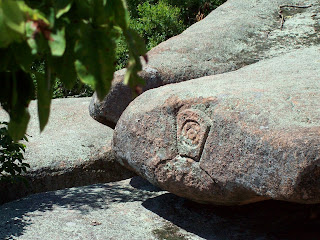Back into the garden, where the most influential change has been the weather... Yes, I know this is a predictable post beginning but Missouri is in the center of the country, where weather moves in like a giant swirling soup. Weather fronts blow by west to east as well as colder air barreling down from Canada and the tropical moisture pushing up from the Gulf. This variability often gives us Missourians weather surprises. Our blazing 90F heat with 58% humidity vanished two days ago and we have lovely 75F days and nighttime temps around 56F. Surely a sample of early Fall in my estimation and it feels wonderful!
The honeybees in my garden are very busy gathering nectar from the plants. I think the cooler temps have made them a bit frantic as they are buzzing about my head if I obstruct their flight path to the flowers. My local nursery has put all their perennials on sale and I have added to the garden some bee favorites: Joe Pye Weed, anise hyssop, bee balm and verbena. A word of caution about buying plants this late in the season, most are terribly pot bound and will have a bit more transplant shock than those bought earlier in the year. Look for plants that have healthy foliage and not many flowers. Be sure to water daily and if they continue to look stressed, meaning wilty, snip off all the blooms, to force energy to the roots. Planting at this time of year is basically planning ahead for next year's garden, by getting the new plants into the ground to form strong roots before winter.
I have been increasingly concerned about the honeybee populations and read the recent article in the August 19, 2013 issue of Time magazine,
A World without Bees, by Bryan Walsh. I have a link to the partial article but you will have to subscribe to Time to read it in total
http://www.time.com/time/magazine/article/0,9171,2149141,00.html In summary, pesticides called neoniotinoids used by commercial agricultural farms are poisoning hives and causing massive bee die offs. Another honeybee stressor seems to fall square onto commercial agriculture as well, which is the monoculture of corn & wheat production, neither having significant pollen production to support the bees. The overall, focus of the article was to increase public awareness that without bees to pollinate, our food supply is seriously threatened. I suppose fear mongering sells magazines but I do believe the decreasing bee population is a real problem.
 |
| Joe Pye Weed |
Perhaps if all of us home gardeners deliberately plan to include nectar rich plants in our gardens, we can foster a resurgence of local honeybees. It's worth a shot and what gardener doesn't enjoy adding a few lovely new plants to the yard? It is also important to carefully use pesticides or better yet go organic, that method has worked for centuries. So back to the plants....
 |
| Anise Hyssop "Heatwave" |
Some excellent nectar rich flower sources are as simple as letting the white clover and dandelions grow in a small portion of your yard, but if that is not an option consider,
Joe Pye Weed (eupatorium purpureum). This plant has lovely bronze foliage, can grow about 4' tall and does spread annually; a one gallon pot will get about 2-1/2' wide in a couple of seasons. It has interesting shaggy pinkish blooms clustered at the ends of the stems and the bees are wild for it. Important to note that it appears later in the Spring, so mark it's spot in the garden to avoid digging it up. My other all time favorites are the
Hyssops (agastache) because each different hybrid has a different flower. In my garden I grow the anise hyssop "Heatwave" which has lovely tubular pink flowers up the stem, and if given a quick trim in the Spring will bush out to a 3'x3' height and width, as an additional bonus it is also a hummingbird favorite. The "Black Adder" Hyssop is more compact, about a foot wide and 2' tall but has purple tubular blooms on a terminal cone and is primarily visited by the bees. Each of these plants grows quickly and does best in full sun.
 |
| "Black Adder" Hyssop |
If you are not sure about which flowering plants will benefit your local honeybee populations take a tour through your neighborhood park or botanical garden, looking for bee laden plants and ask questions. Many nurseries have a staff member that can direct you to the plants they sell that attract bees, butterflies and hummingbirds. Your local library will also have gardening books that are a wealth of information, even if you can only manage a five gallon bucket garden on your porch. Take a walk around your neighborhood, it might be enlightening as you never know who is a gardener until you start to look for gardens and gardeners watch bees. Another option is to check in with your local Bee Keepers Association, yep, there is honey everywhere, and these folks will also be most informative. So
catch the buzzzzz and bee beneficial!
*remember to click on the pictures for a larger view & see the bees










